Lectric XP Trike2 Review | Limited Mobility Can’t Limit You
With a redesigned frame, lots of upgrades, and the same ultra-affordable price, America’s best-selling electric tricycle looks, rides, and performs better than ever.
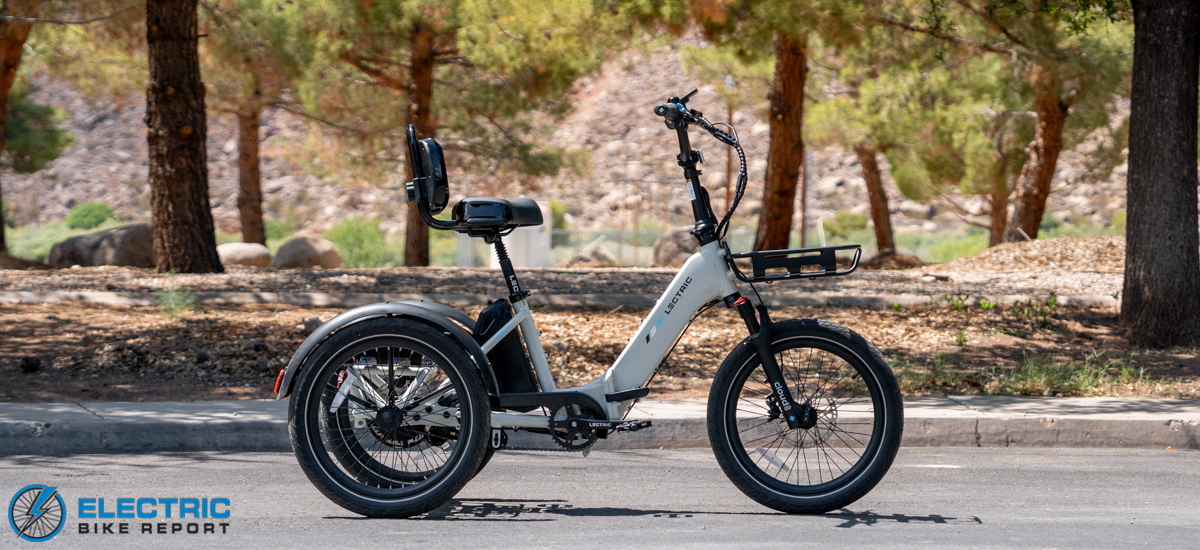
Like a massive container ship in a small harbor, Lectric seemingly can’t help but make waves. For good reason, too! The brand largely dominates the American e-bike market due to its commitment to quality, value, and affordability.
Case in point: at the time the original XP Trike was released, electric tricycles were tough to find for less than $2500. Lectric shook up the status quo by releasing a custom trike that undercut most of its competitors by $1k. Now, the XP Trike2 boasts a boatload of impressive upgrades and the same remarkably affordable price.
So what new things did Lectric manage to pack into the XP Trike’s successor? In addition to a redesigned (and, in our opinion, much better-looking) frame, the Trike2 features a suspension fork and seatpost, improved brakes, and a color display. It also offers turn signals, multiple color options, and a quieter motor.
Holy ship!
Clearly, the XP Trike2 has raised the bar again in terms of overall value, but real-world aspects such as comfort and performance are more important than a decked-out spec sheet. This is where our team of expert testers and reviewers comes into the picture.
We tested the XP Trike2’s speed and programming, braking power, climbing capability, and range in a series of standardized performance tests. Read on below (or check out the link to our video review on YouTube) to find out how Lectric’s new and improved e-trike felt and performed!
Class 2 (throttle to 14 mph)
 Pros
Pros- At $1500, the XP Trike2 is among the lowest-priced e-trikes we’ve seen. It’s arguably the best value trike on the market
- It has a remarkably sturdy and stable feel with a comfortable ride. The new frame design and suspension paid off!
- Other great upgrades (things you’re not likely to find elsewhere) include more powerful brakes, a color display, integrated turn signals, and a super quiet motor!
- With a total payload capacity of 415 lbs and compatibility with front and rear cargo racks/baskets, it’s a great option for heavier riders or those seeking utility.
- It has many adjustment points to dial in the fit, allowing it to work for riders between 4’10” and 6’2”.
- The Beginner Mode keeps speeds and power levels safe and low for those new to electric trikes.
- Users can choose multiple throttle modes through the display. We like that its speeds are limited by the pedal assist system by default.
- An even better-equipped 750W model with a torque sensor and more color options is set to be available in the near future.
 Cons
Cons- We’re more than satisfied with its value and upgrades, but the XP Trike2’s battery capacity is technically a downgrade from the previous model.
- A folding frame adds the convenience of portability, but it requires a few disassembly steps to fold completely, and is still relatively heavy at roughly 83 lbs (with the battery removed).
- Battery:48V, 624 Wh (13Ah), removable
- Display: custom color TFT LCD, detachable, with USB-C
- Motor: 48V, 500W (1092W peak) Stealth M24 motor, 65 Nm torque
- Headlight: Integrated 90-lumen headlamp with side amber lights
- Taillights:Integrated brake-activated rear light with turn signals
- Pedal Assist: Five riding modes (Eco, Tour, Sport, Sport+, & Turbo)
- Claimed Range: Up to 50 miles
- Throttle:Half-twist throttle
- App:None
- UL Certification: UL 2271, UL 2849 Certified
- Claimed weight: 86 lbs (including 7 lb battery)
- Tested Weight: 91.1 lbs (including 8.5 lb battery)
- Rider height range: 4’10” – 6’2”
- Total payload capacity: 415 lbs
- Brakes:Star Union hydraulic disc brakes, 180mm x 2.3mm rotors
- Fenders:Polypropylene
- Fork:Cloud 50, 50mm travel, with lockout and preload adjustment
- Frame: hydroformed 6000-series aluminum, folding
- Drivetrain:Single-speed, 36T chainring, 16T freewheel, KMC Z8 chain
- Grips: Ergonomic lock-on
- Saddle: Custom
- Handlebar: 25”
- Kickstand: Parking brakes
- Pedals: Custom-designed 6000 Series Aluminum
- Tires: Puncture-resistant 20” x 2.5”, with slime
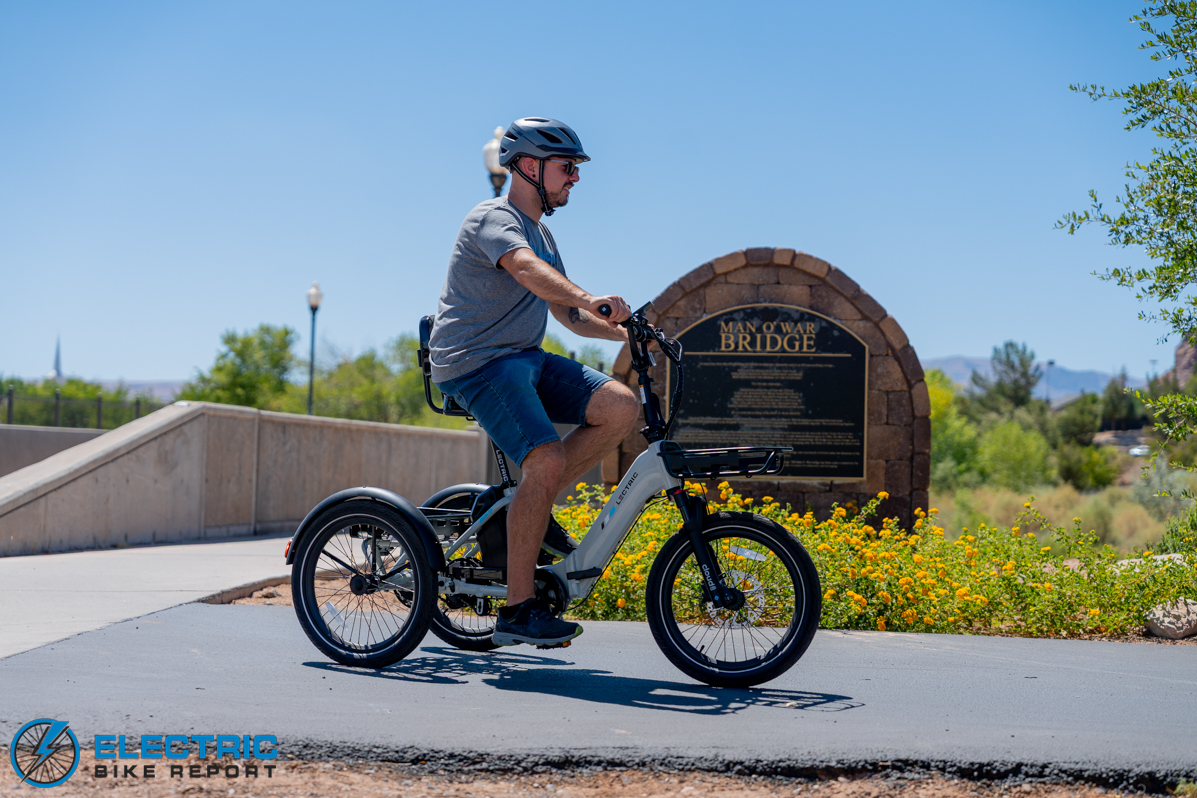
The XP Trike2’s 415-lb payload capacity includes up to 330 lbs for the rider, up to 30 lbs in the optional front basket, and up to 75 lbs on the rear rack.

The 500W motor is mounted between the rear wheels. It ties to a differential axle to allow for turning.
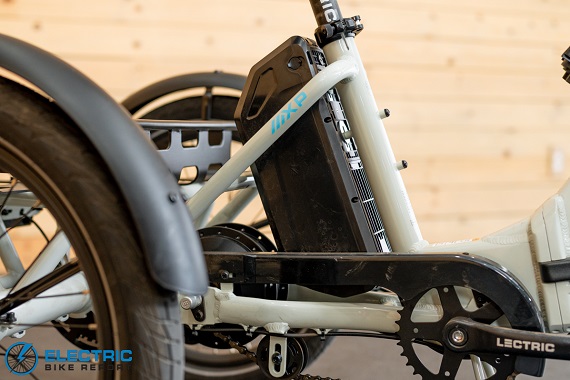
A 624-Wh battery mounts behind the trike’s seat tube. Lectric advertises a range of up to 50 miles, which we tested.
Lectric XP Trike2 Review: Speed Test
Knowing how fast an electric bike or trike can go is an important piece of information to learn when shopping around. I tested the XP Trike 2 by riding it on a paved, relatively flat shared-use path in each of its five pedal assist system (PAS) settings.
Lectric advertises that the XP Trike2 has a maximum speed of 14 mph, but to make it safer and more approachable for new riders, Lectric programmed it with a Beginner mode. When active, this mode limits the two lowest assist levels to 5 mph and reduces the overall speed limit to 12 mph.
I performed a test in both the Beginner and Standard modes; my results are shown in the graph above.
The data from my Beginner mode shows that the advertised limitations were accurate. The trike adhered to its five mph maximum speed in Eco and Tour modes, while Sport + and Turbo reached the 12 mph ceiling. The regular Sport mode offered a comfortable middle ground between the high and low speeds that skewed more towards the high end.
I found all of the trike’s power levels to be approachable in this mode, with gradual acceleration and a controlled, steady feel. Pedaling in Eco and Tour felt natural, with my pedaling seemingly contributing to moving the trike more than the motor.
This changed in the higher assist levels; at around 9.5 mph, the motor powered me above the speed at which my pedaling contributed, at least without pedaling unnaturally fast. This phenomenon, which is called ghost pedaling, is normal and expected based on our experiences with similar models; the result is a relaxing and low-effort experience.
In the Standard mode test, the trike’s starting speed was higher, with more incremental steps up in speed between assist levels. Eco felt natural and approachable, while Tour kicked up the power to help me move around faster. The three highest assist levels were all able to reach the 14 mph maximum, though each delivered increasingly faster acceleration.
Compared to the previous model, its programming did not appear to have changed; the graphs of our Beginner and Standard mode tests seem nearly identical. Our contact at Lectric confirmed that our assumptions were correct; when compared with the original XP Trike, the motor output (in amps) remains the same across all pedal assist levels with the Trike2.
In both cases, the programming and two riding modes offer a range of power levels and speeds that should work for new and experienced users alike.
As another component of this test, I evaluated the XP Trike2’s throttle speeds and acceleration. By default, the throttle shares the same speed/power limits as the PAS, so in Standard mode, Eco carries the trike to around 7-7.5 mph, and Turbo can reach the same 14 mph maximum. Users can, however, choose to allow the throttle to reach maximum speed in all PAS settings if they prefer.
Also, by default, the throttle can function from a complete stop, but users can change this setting to require the trike to be moving before the throttle can engage. While this prevents it from engaging unexpectedly, we found that the throttle was useful to get moving because the motor took a few seconds to engage when pedaling.
At low assist levels, the throttle felt gradual and safe; in our opinion, this is an essential element of an electric trike! The same feelings were present at higher settings as well, though there was noticeably more force behind the trike’s acceleration.
Overall, the XP Trike2 performed well in this test; its programming, speeds, and power levels matched both Lectric’s descriptions and our expectations.
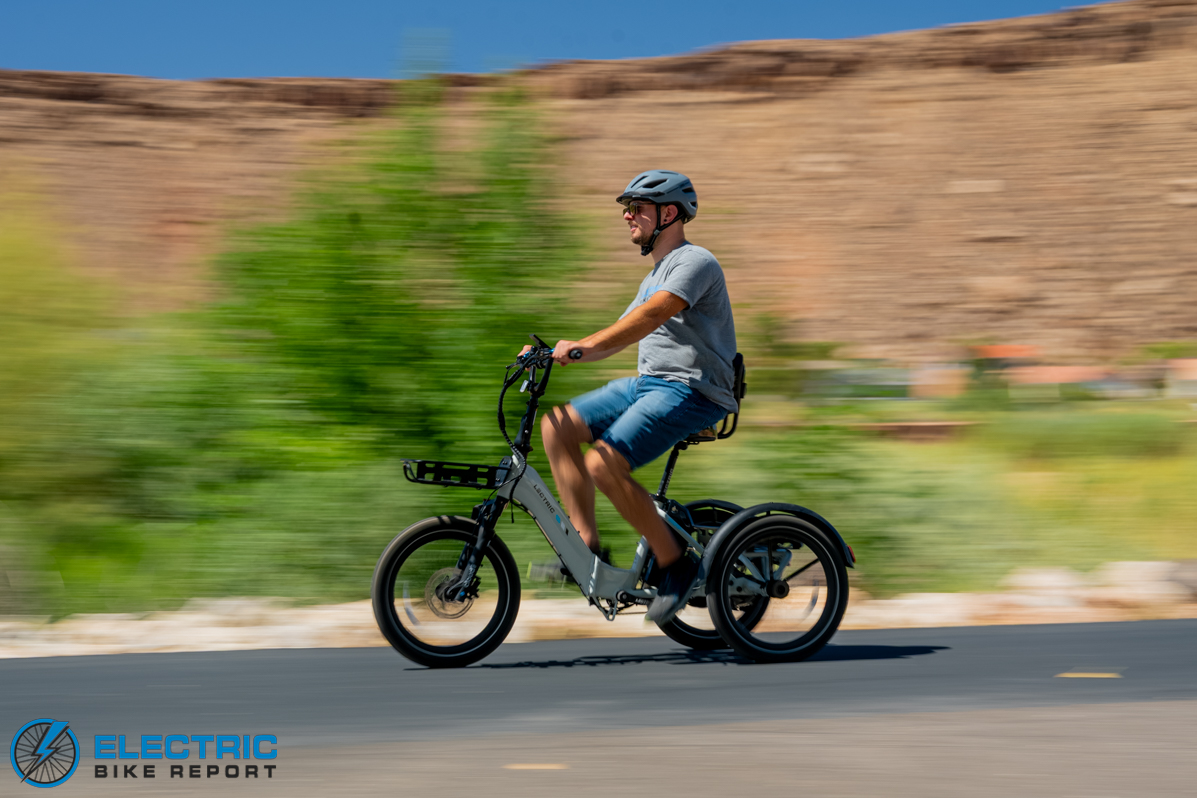
While the XP Trike2’s maximum speed is 14 mph, it also features a safer, slower Beginner Mode with more restricted speed limits of 5 mph and 12 mph.
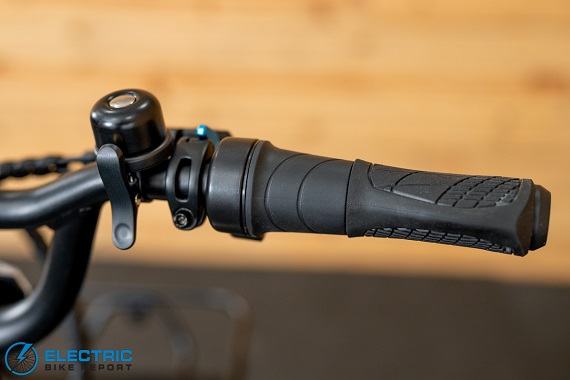
A half-twist throttle on the right handlebar can help get the trike moving or provide an easy cruising experience.
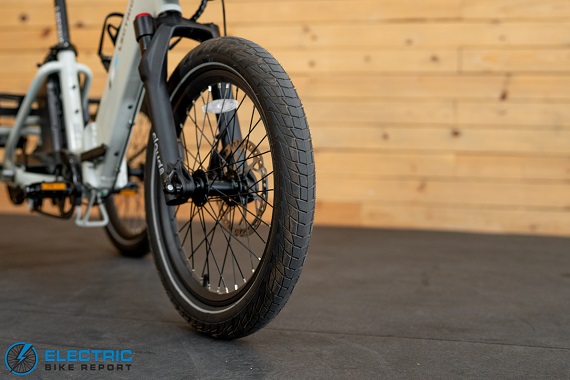
The trike’s 20×2.5” street tires worked well on paved surfaces.
Lectric XP Trike2 Review: Range Test
Lectric advertises a range of up to 50 miles with the XP Trike2’s combination of a 500W motor and a 624-watt-hour (Wh) battery. Using the method described in the graphic above, we determined that the brand’s advertisements are accurate; our test riders traveled 30.6 miles using the trike’s highest level of pedal assist and 52.3 miles with its lowest.
Similar electric tricycles we tested averaged 30.6 and 48.5 miles, so the XP Trike2 was roughly average in comparison. We always applaud average performance (especially on affordable/entry-level models), as those numbers indicate that the model we’re testing is well-specced and able to keep pace with its peers.
It is worth noting that the Trike2’s 624 Wh battery is somewhat smaller than the original XP Trike’s 672 Wh power supply. This is an area where Lectric likely made a compromise to balance the new model’s upgrades and low price, which we consider to be more than a fair trade in the current market, though it is admittedly somewhat of a downgrade.
The difference in capacity was noticeable in our high-power range test; the original model traveled nearly 40 miles while the XP Trike2 only slightly exceeded the 30-mile mark. In our low-assist test, however, the Trike2 proved equally efficient. Its result of 52.3 miles differed little from the original XP Trike’s 53.5-mile result.
In the big picture, the XP Trike2’s motor proved more efficient than expected. Based on its battery capacity and motor specs, we estimated that its Turbo mode test would last roughly an hour and 15 minutes, yielding only around 17 miles of range. Its 30+ mile result, which was measured over the course of 2 hours and 15 minutes, shows a 76% increase beyond our expectations in time and a 76% increase in distance.
Considering that a majority of the e-trike riders we’ve interacted with usually travel distances well within the XP Trike2’s range of results, it’s likely that most users should get multiple trips from a single charge. Our Speed Test results reinforce this; the trike’s ability to reach its top speed using mid-power assist levels shows that at least some riders should be able to use one of the trike’s more efficient settings to conserve power.
One minor point of critique is the XP Trike2’s method of displaying its battery charge level. While I generally like the display (more on that later), its percentage-based readout drops in increments of 10%, making it effectively bar-based and somewhat inaccurate. After spending some time in the saddle and learning its patterns, however, I was better able to predict the trike’s remaining charge and range.
Once the battery is fully drained and recharging is necessary, the standard 2-amp charger should complete the process in roughly 6.5 hours. Those who want to reduce the trike’s charging time can upgrade to a 5-amp fast charger with the ability to recharge the power source in less than 3 hours.
Again, based on its performance in this test, we consider the XP Trike2 to be successful and well-specced!
Lectric XP Trike2 Review: Hill Test
Hill-climbing power is another essential metric to evaluate and be aware of; we tested the XP Trike2’s capabilities using the method described above. Our test rider, Justin, completed both the throttle and pedal portions of the test in what we consider respectable times, though comparison with similar models is difficult.
We recently moved (read: were forced to relocate) our Hill Test to the Devil’s Backbone, and as such, we are in the process of building a new dataset. At the time of writing, the XP Trike2 is the only electric tricycle we have tested at the new location.
To gather more data, I tested the XP Trike2 both with and without 60 lbs of cargo on its rack at our secondary test location, called Pilot Hill. This hill is less intimidating than the Devil’s Backbone, with just under 100 feet of elevation gain and an average grade of around 6%, though it still presents a tough climb that most cyclists choose to walk up.
There, the XP Trike2 completed an unladen trip up the hill in 1:29 using its throttle and 1:30 when pedaling. With weight added to the optional rear cargo basket, my times lengthened to 1:47 when throttling (a difference of 18 seconds, or 20.2%) and 1:40 in Turbo mode (a 10-second difference, or 11.1%).
An extremely similar model we tested recently scored 1:32 and 1:29 at the same location when riding without cargo. Its times were 1:45 and 1:33, with the same amount of weight in its cargo basket. Overall, both trikes shared similar performance and test completion times. As with the Range Test section above, this indicates that the XP Trike2 is capable and well-specced.
Ultimately, we tend to evaluate electric trikes on their ability to complete our formal Hill Test, rather than their speed when doing so. In my experience, the XP Trike2 felt powerful enough to handle hills and heavy loads without being hindered. Its performance scores and the fact that it completed our tests at both locations serve to reinforce its effective climbing ability.
In our book, that means a job well done.
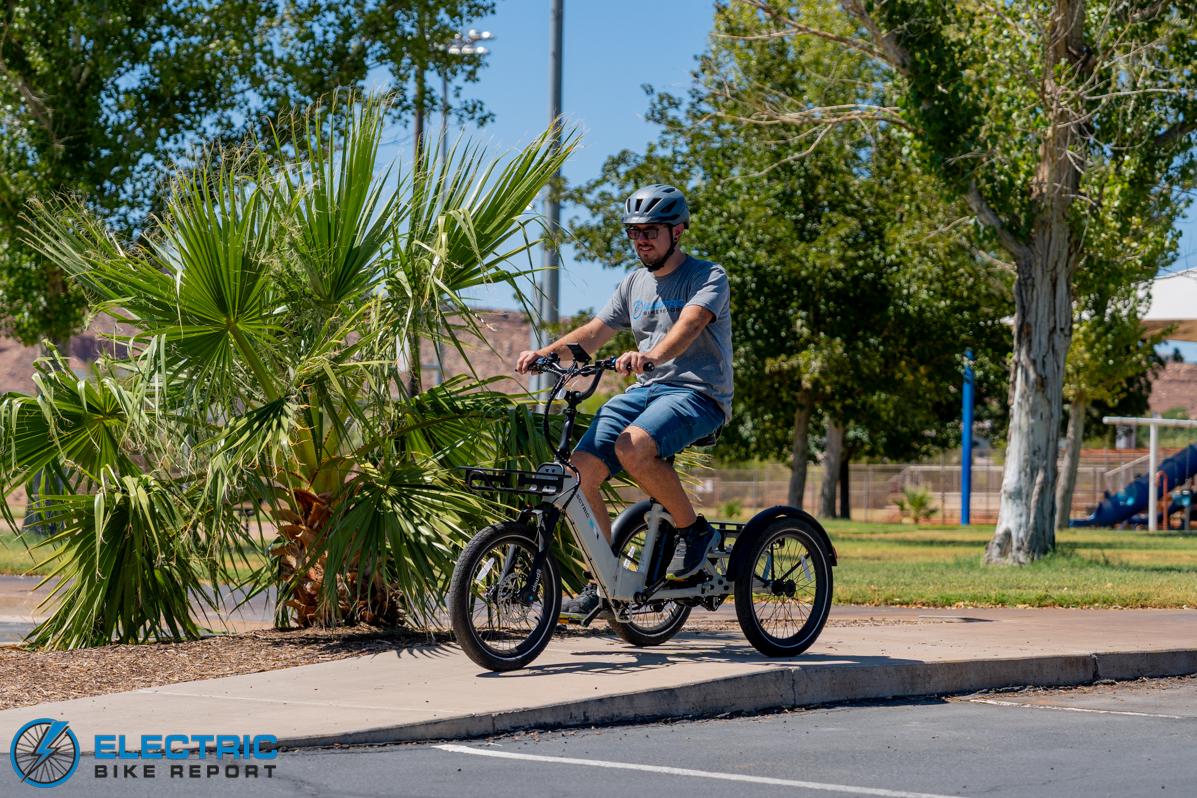
A significant component of the XP Trike2’s ride is its sturdy, planted feel, which results from its relatively robust frame. We’re also happy to see three total color options!
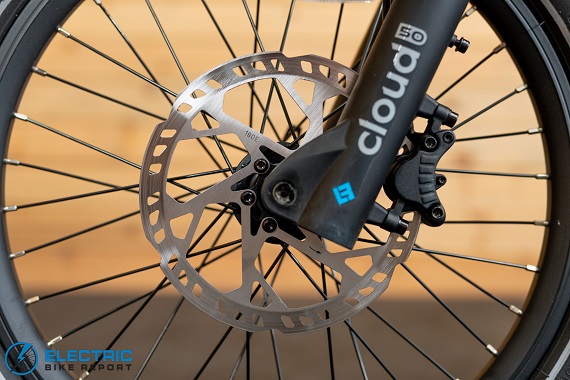
The XP Trike2 comes equipped with powerful Star Union hydraulic disc brakes with a parking brake function.
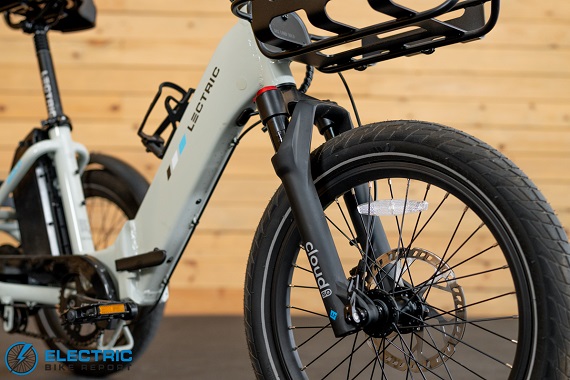
A front suspension ensures that bumps are absorbed by the trike, not your arms or wrists.
Lectric XP Trike2 Review: Brake Test

We tested the XP Trike2’s braking performance using the method described above; its average stopping distance was an impressive 12’6”.
I was surprised to note that the current average for all comparable e-trikes we’ve tested was an average of 12’3”; this goes to show that most have impressive stopping power and that the XP Trike 2 is relatively average in comparison.
It’s worth noting that the trikes we’ve tested have had a variety of different speed limits and brake types. A handful have had similar 14 mph speed limits and similar hydraulic disc brake systems, but others have been faster, used coaster or mechanical brakes, or came equipped with three calipers and rotors instead of two.
As such, an apples-to-apples comparison is not possible, but we can consider that the XP Trike2 showed noticeably better performance than the original XP Trike, which scored 13’2” in this test.
The upgrade was noticeable in both appearance and feel. The Trike2’s Star Union hydraulic brake system features thicker rotors (2.3mm vs. 1.8mm), which are better able to dissipate heat. Additionally, it has more robust brake levers, brake lever bodies, and parking brakes compared to the previous model.
There were times that I applied the brakes and thought to myself that I would likely not want them to be any more powerful; braking could be fast and slightly aggressive, which was also confidence-inspiring. I paid particular attention to their performance when riding down Pilot Hill (described above) with 60 lbs of cargo; the brakes easily controlled my speed and stopped the trike safely before arriving at a busy intersection.
All in all, the brakes proved mighty, safe, and quite effective; the XP Trike2 has earned our approval based on its feel and performance.
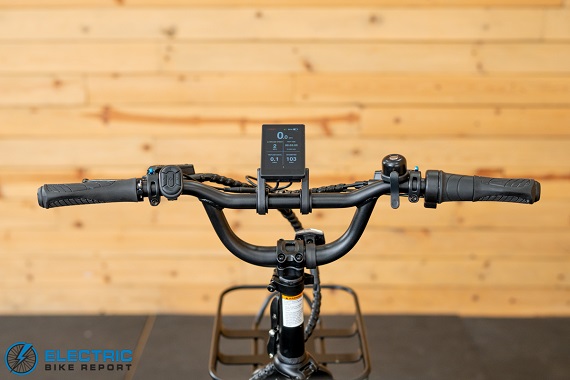
Users can adjust the trike’s reach by rotating the 25” handlebars closer or further away.
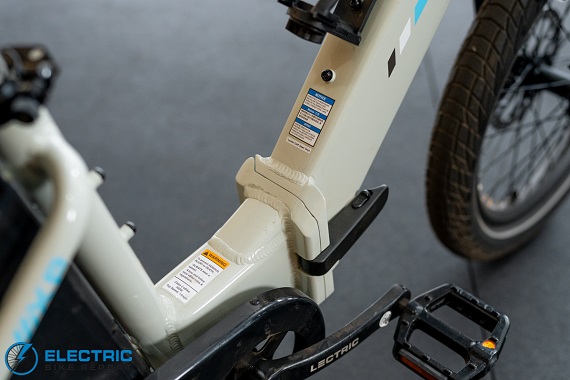
The trike’s frame includes a central hinge that allows it to fold for storage or transport.
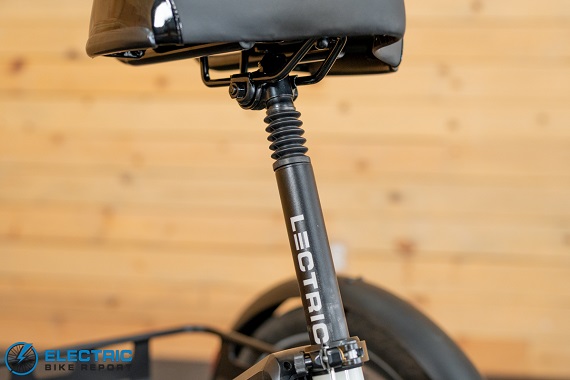
Our test trike came with a suspension seatpost, which gave the ride a smooth and enjoyable feel.
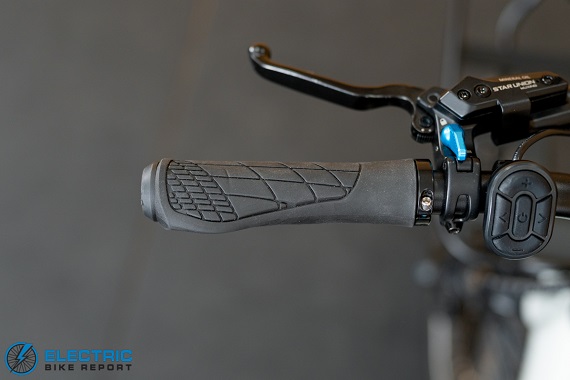
We liked many of the Trike2’s smaller upgrades, including the ergonomic rubber grips and rubberized button pad.
Lectric XP Trike2 Review: Ride Quality
Ride quality is a measure of how a bike feels to ride, and is naturally more subjective than our performance tests above. The subject of ride quality factors in a variety of elements, including geometry and sizing, suspension, handling, motor engagement, the user interface, etc.
Overall, the XP Trike2’s ride quality was excellent. The new model’s redesigned frame and upgraded components all worked well to make the experience of using it comfortable and enjoyable, though we did identify a few areas with room for improvement.
Lectric makes the XP Trike2 in a single frame size that is intended for riders between 4’10” and 6’2”. We feel this height range is somewhat more appropriate than the original model’s top end of 6’4”, as the first XP Trike could feel somewhat limiting for taller riders.
Accommodating such a broad range of riders is no easy task, but the XP Trike2 offers multiple adjustment points to dial in its fit. A long seatpost provides 12” of adjustment in its saddle height, the telescoping stem offers 3-plus inches of handlebar height adjustment, and with a set of BMX-style handlebars, riders can rotate the handlebars to adjust reach.
At 5’11”, I found a very comfortable fit and riding position. I didn’t find that I needed full leg extension due to the trike’s propensity for ghost pedaling (as discussed above, this is a natural side effect of single-speed drivetrains), and the reach felt comfortable without being cramped or too stretched out.
Like the original mode, the Trike2’s geometry gave the sense of pedaling somewhat below and behind the usual position of a bicycle, though I found that the sensation was lessened by keeping the pedals more in the middle of my foot than the ball of my foot.
In terms of contact points, I found the thick saddle with its adjustable backrest to be comfortable and supportive. I also liked the ergonomic rubber grips and Lectric’s custom aluminum pedals.
As I touched on previously, some of the Trike2’s upgrades are a custom suspension fork offering 50mm of travel and a suspension seatpost with 40mm of travel (an accessory that previously needed to be added separately). The combination of suspension components made for a generally smooth and enjoyable ride; I could still feel large bumps, but their impact was significantly reduced.
The tires are a set of relatively smooth 20×2.5” street tires that provide great traction on paved surfaces. This is partly a result of the Trike2’s mid-mounted hub motor and differential axle, a design that Lectric popularized with the previous XP Trike, as it delivers power to both rear wheels, which are also largely beneath the weight of the rider.
Personally, I liked that the previous model came with knobbier tires that allowed for light off-roading on smooth dirt or gravel roads; the XP Trike2 would likely be more comfortable in such conditions due to its suspension, but its street tires naturally won’t have as much grip. Fortunately, tires are an easy and relatively affordable thing to upgrade!
Let’s take a moment to discuss the XP Trike2’s folding ability. Like the previous model, its frame is hinged, allowing the front end to swing around and tuck between the frame and the left rear wheel. This feature, which is relatively common on e-trikes, has the potential to enable the XP Trike2 to become more compact for storage or transportation.
As a downside, it’s worth noting that at 91 lbs (including an 8.5 lb battery), the XP Trike2 can be both heavy and cumbersome. We recommend at least two sets of youthful and capable hands when moving it or loading it into a vehicle. Additionally, to fully fold the trike, its front wheel and fenders must be removed, making the process somewhat lengthy and involved.
On the plus side, I noticed that the Trike2 felt noticeably more sturdy and stable while riding than the previous (and noticeably lighter) model. Delta-style tricycles (one wheel at the front and two in the rear) can be notoriously easy to tip up on two wheels when cornering, but the XP’s weight kept it well planted during my testing.
I was pleased to note that the XP Trike2 included turn signals and a total of three brake lights for visibility. It was also great to see a chain guard included, though I’d prefer a thin-gauge aluminum to the relatively thin plastic for the sake of durability.
In terms of the user interface, I was very much a fan of Lectric’s new color display, which included color-coded PAS settings, a power meter, and all the usual ride data presented in a clean and easy-to-read manner. I also liked its settings menu, which offers a handful of customization options for the riding mode and throttle behavior.
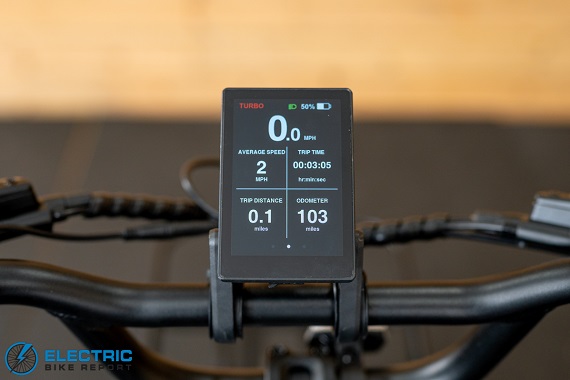
The new color TFT display was a highlight. Color-coded PAS settings made it easy to know which power level was selected.
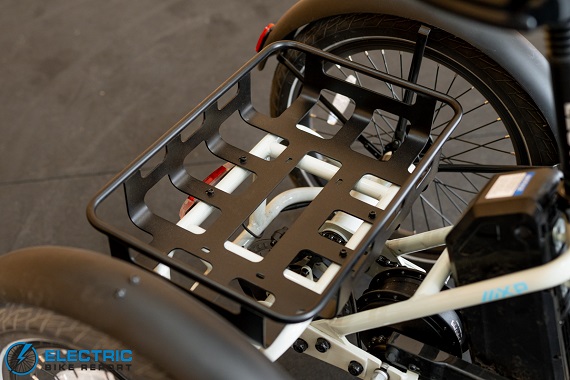
While the XP Trike2 doesn’t include them, Lectric offers an optional Cargo Package with both front and rear cargo baskets.
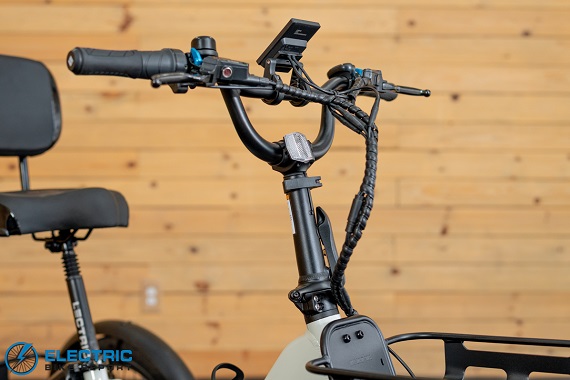
The trike’s handlebars mount to a collapsible, telescoping stem that offers over 3” of height adjustment.
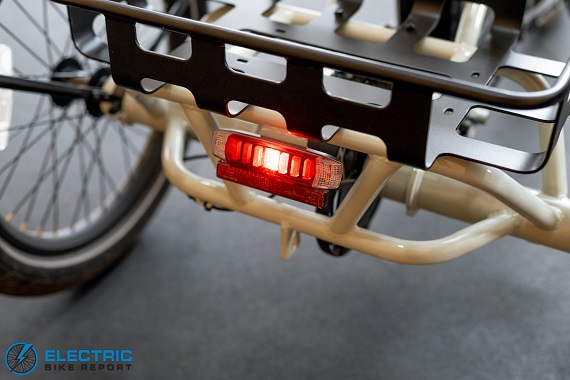
The trike includes both brake lights and turn signals to communicate with other drivers/cyclists on the road.
Lectric XP Trike2 Review: Summary / Where to Buy
Having tested a number of e-trikes, including the best electric trikes on the market, I can say that I have rarely been as impressed by any model as I was with the XP Trike2. It simply felt safe, sturdy, comfortable, and well put together. I also found it easy to operate and capable as both a utility device and a method of experiencing enjoyment or exercise.
I’m left with a similar sense that I had after recently reviewing the Lectric XP4 folding e-bike. It’s truly hard to wrap my head around the XP Trike2’s excellent ride experience while at the same time considering its remarkably affordable price; it’s further evidence of how far Lectric has evolved as a brand.
Of course, the Trike2 is not a perfect machine, but its few downsides are reasonable trade-offs for its low price and overall value. Most riders likely won’t mind the slightly shorter range in high power levels that comes as a result of its smaller battery (when compared with the previous model).
Additionally, the trike’s weight and relatively complex folding process may make it relatively tough to move or lift when stationary. However, while I could be wrong, I would hazard a guess that those making use of the folding frame might be in the minority.
Otherwise, the XP Trike2 performed extremely well, with average to above-average performance in all areas of our testing. It offers a wide range of speed and power levels, making it practical and approachable for both new and experienced riders. It demonstrated respectable, usable range and climbing power. Finally, its brakes felt powerful and well-balanced in relation to the trike’s speeds and weight capacity.
I appreciated all of the trike’s upgrades, especially ride-quality-enhancing items like the display, rubberized control pad, turn signals, and suspension. I must also give Lectric kudos for the Trike2’s appearance; it’s a sleeker, more appealing design than the original model, and it’s also offered in more color options.
My experience makes it easy to recommend the XP Trike2 for those seeking a safe, high-quality, budget-friendly, and fun-to-use electric tricycle. Whether you’re disabled, aging, or simply prefer the added stability of three wheels to two, Lectric’s trike is well-suited for cruising, running errands, and otherwise getting out and about.
One final note: the brand is slated to release an upgraded model of the XP Trike2 in the near future. This e-trike will have a more powerful 750W motor, a torque sensor, a larger battery, and a much wider variety of colors. We look forward to receiving, testing, and reviewing this model; stay tuned for updates!
Otherwise, the XP Trike2 performed extremely well, with average to above-average performance in all areas of our testing. It offers a wide range of speed and power levels, making it practical and approachable for both new and experienced riders. It demonstrated respectable, usable range and climbing power. Finally, its brakes felt powerful and well-balanced in relation to the trike’s speeds and weight capacity.
I appreciated all of the trike’s upgrades, especially ride-quality-enhancing items like the display, rubberized control pad, turn signals, and suspension. I must also give Lectric kudos for the Trike2’s appearance; it’s a sleeker, more appealing design than the original model, and it’s also offered in more color options.
My experience makes it easy to recommend the XP Trike2 for those seeking a safe, high-quality, budget-friendly, and fun-to-use electric tricycle. Whether you’re disabled, aging, or simply prefer the added stability of three wheels to two, Lectric’s trike is well-suited for cruising, running errands, and otherwise getting out and about.
One final note: the brand is slated to release an upgraded model of the XP Trike2 in the near future. This e-trike will have a more powerful 750W motor, a torque sensor, a larger battery, and a much wider variety of colors. We look forward to receiving, testing, and reviewing this model; stay tuned for updates!
Happy Riding! Make sure to let us know if you have any questions or if you think we left anything out in this review of the Lectric XP Trike2 down in our comments section.




I just got my Trike 2 and I love it. I’m 4’11”, and the fit is good. The only problem is the back tires are wobbly. I contacted customer support and they seem very easy to work with. I sent videos and am waiting for a response.
Glad to hear that you’re happy with it! Keep us posted on how things work out with the back tire fix.
That’s a bicycle with 2 wheels stuck on back.